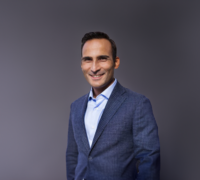
Speaking up and staying strategic
When talk of diversity triggers backlash, leaders face a paradox: how to advance inclusion goals while choosing language that keeps dialogue alive in hostile environments....

by Luca Condosta, Alexander Fleischmann Published October 24, 2025 in Diversity, Equity, and Inclusion • 8 min read
Current discussions around diversity, equity and inclusion (DE&I) often focus on the perceived backlash, particularly in the US market. Yet data keeps telling a different story: the business value of DE&I and of LGBTQ+ inclusion endures.
One of the most recent accounts is the Open for Business 2025 Swiss Market Leaders LGBTQ+ Inclusion Transparency report, which found that companies with high LGBTQ+ transparency outperform those with low scores by eight percentage points in return on equity (ROE). While correlation doesn’t necessarily mean causation, this performance gap has clear business implications.
“What that demonstrates is enhanced risk management,” explains Ken Janssens, incoming CEO of Open for Business. “They also do much better in communicating to their stakeholders and it better positions them to cope with and thrive in challenging and changing markets.”
The resilience factor extends beyond financial metrics. Companies with diverse, inclusive environments avoid “groupthink” and make better decisions because employees “bring with them and can apply a range of different backgrounds and different lived experiences,” Janssens adds.
The distribution of Swiss corporate inclusion practices reveals both challenges and opportunities. According to the 2025 Open for Business Swiss report, nearly nine in 10 (86%) major Swiss companies remain in the lower transparency categories, compared to 57% in their 2024 global study of 290 companies across the US, the UK, Germany, and Australia.
Market Leadership. Swiss companies with high LGBTQ+ inclusion transparency are 2.2 times more likely to be market leaders.
The Inclusion Dividend. Top-quartile transparent companies achieve an average Return on Equity of 26.19%, significantly outperforming the bottom quartile’s 18.22%. Transparency Gap. 86% of major Swiss companies exhibit minimal LGBTQ+ inclusion transparency, presenting substantial first-mover advantages.
Generational Shift. Those 86% of Swiss companies risk falling behind Gen Z expectations. As Gen Z enters the workforce and consumer markets, companies lacking LGBTQ+ inclusion transparency face mounting pressure to stay relevant.
This distribution also suggests that Swiss companies may not yet fully recognize inclusion’s potential as a business driver. Janssens sees this as “a fantastic opportunity for a lot of Swiss companies to take advantage by simply moving beyond that base level.”
For companies beginning their inclusion journey, engaging with employees through surveys or focus groups provides a crucial starting point. This baseline assessment not only reveals current employee experiences and needs but establishes measurable benchmarks against which future progress can be tracked, signals accountability, and demonstrates genuine commitment to change.
The data shows that while more than half (52%) of Swiss companies report having employee resource groups, only six percent have consumer-facing LGBTQ+ programs – a gap that represents untapped market potential given the estimated $4.7tn global LGBTQ+ consumer spending power.

“Get your house in order before you start pushing it externally.”
Based on 11 years of global benchmark data from large organizations, Workplace Pride’s research shows companies typically progress through internal measures before moving to external initiatives. As Brian Yothers, Director of Operations at Workplace Pride consistently observes: “Get your house in order before you start pushing it externally.”
The recommended route map, focusing first on policies and benefits via clear policy language, serves two purposes: “In black and white, words confirm to those that are engaged in LGBTQI+ inclusion – and demonstrate to those that are skeptical and not yet engaged – that there is an effort of explicit inclusion for this group of employees.” This builds psychological safety which promotes the cultural foundation and credibility necessary for broader inclusion efforts.
However, Yothers identifies one external area where companies shouldn’t wait: strategic sourcing. If internal anti-discrimination policies exist and include policies that protect LGBTQ+ people, companies should seek to extend these requirements to suppliers and partners, creating “an ecosystem of people that you’re working with.”
Yothers emphasizes that their benchmark deliberately aims to provide a roadmap to enable progress and de-emphasizes the competitive side of comparisons to other organizations. It recognizes that many organizations taking their first inclusion steps initially record very low scores – typically in the 20% achievement range. “We intentionally design the process to be non-threatening, allowing companies to participate without public disclosure, with the primary goal of providing an internal improvement tool rather than a comparative ranking,” he explains. By removing this competitive pressure, Workplace Pride encourages organizations to continue their inclusion journey even when initial performance seems poor. An example of a generic Global Benchmark report can be found here.

Historical data reveals that while inclusion efforts often start bottom-up through employee initiatives, sustainable progress requires genuine leadership support. Yothers emphasizes this distinction: an executive sponsor appointment “is different than someone who’s really engaged and supportive.”
Common to Workplace Pride and Open for Business is that both suggest. This strategic elevation helps build what Janssens calls “competitive advantage,” particularly crucial as Generation Z – who will comprise one-third of the global workforce by decade’s end – increasingly prioritize ethical business practices, inclusion, and public values alignment in their employer choices.
Companies that visibly support LGBTQ+ inclusion can differentiate themselves in competitive talent markets, where younger demographics view workplace diversity as a non-negotiable expectation rather than a nice-to-have benefit. This positioning becomes especially valuable in sectors competing for the same diverse talent pools, creating tangible employer branding advantages that translate directly into recruitment success.
This once more underscores why inclusiveness is not a trend, it’s a test of leadership – requiring active engagement rather than passive waiting for cultural shifts to occur.
Despite concerns about DE&I rollback, particularly in the US market, the data suggests most companies are maintaining their inclusion efforts while adjusting their communication strategies.
Despite concerns about DE&I rollback, particularly in the US market, the data suggests most companies are maintaining their inclusion efforts while adjusting their communication strategies. Janssens observes that while some US companies are “being a lot less visible” in their reporting, “most say, yes, we’re continuing, but we’re talking about it differently.” So, these companies adopt what he calls “green hushing” – or, in this context, “pink hushing” – continuing the work with a lower public profile. Some also opt for rebranding LGBTQ+ initiatives under broader intersectional frameworks that include “women and disabilities and everyone.” European companies, in contrast, appear more resilient. As Janssens notes, Europe is holding up “extremely well,” with companies remaining committed to LGBTQ+ inclusion.
Yothers sees similar patterns in his benchmark data: companies are changing surface-level communications but maintaining core inclusion structures like employee resource groups and benefits. The fundamental work continues even as public positioning evolves. LGBTQ+ employees are hyper-aware of these changes and companies should focus on how they communicate and implement these changes to avoid disenfranchising their workforce. This is specifically relevant for companies with employee resource groups as the work they do is very often done on a voluntary basis, in addition to their full-time ‘day job.’

Top leaders must clearly and authentically communicate that it’s “the right thing to do,” and that LGBTQ+ inclusion benefits the business. Starting from this clear commitment, successful implementation of LGBTQ+ inclusion follows a maturity progression that can be implemented systematically.
Internal Foundation (Years 1–2) Establish clear non-discrimination policies explicitly including sexual orientation, gender identity,n, and intersex people. Set up employee resource group guidelines and executive sponsorship. Launch awareness campaigns and internal communication initiatives. Review and enhance employee benefit policies for inclusive coverage.
Systemic Integration (Years 2–4) Conduct external assessments through organizations, for example, with the Workplace Pride Global Benchmark. Implement comprehensive learning paths and ally development programs. Partner with LGBTQ+ organizations and talent acquisition specialists. Adjust codes of conduct to include zero tolerance for discrimination. Establish inclusive employee benefit policies.
Strategic Advancement (Years 4+) Focus on advocacy through value chains and with other companies. Explore inclusive employee benefit policies. Develop consumer-facing programs and marketing initiatives. Consider LGBTQ+ workforce targets and board diversity inclusion.
This progression reflects real-world experience. As Yothers advises organizations: “You can’t do it all at the same time. In fact, you should, because that’s how you achieve and maintain that highest level of maturity.” Create a strong foundation of policies and benefits, authentic leadership understanding and support and then you can move to communication, learning, ally programs and more.
What we at Open for Business are all about is making the business case and the economic case. That is something that most businesses can still get behind and feel comfortable doing.
As Janssens emphasizes, this isn’t just about doing the right thing; it’s about business fundamentals: “What we at Open for Business are all about is making the business case and the economic case. That is something that most businesses can still get behind and feel comfortable doing.”
For business leaders in Switzerland and beyond, the data suggests that LGBTQ+ inclusion shouldn’t be a tactical nice-to-have diversity initiative – rather, it should be regarded as a strategic capability that separates resilient, high-performing organizations from the rest.

Head of Social Progress and Sustainability Capability building, LGBTQ+ Global Program
Luca Condosta is a transformational leader with a robust track record of driving change at the intersection of people, sustainability, and data. With a deep commitment to diversity, equity, and inclusion, his expertise spans over 20 years across multiple sectors, including telecommunications, oil and gas, and energy. He holds a PhD in business administration from Catholica University (Milan) with a focus on sustainability strategy, and master’s degrees in sustainable leadership, and business and climate change from Cambridge University. Luca was named on the 2024 Outstanding Role Model List that recognizes executives who paved the way for LGBTQ+ inclusion at work.

Equity, Inclusion and Diversity Research Affiliate
Alexander received his PhD in organization studies from WU Vienna University of Economics and Business researching diversity in alternative organizations. His research focuses on inclusion and how it is measured, inclusive language and images, ableism and LGBTQ+ at work as well as possibilities to organize solidarity. His work has appeared in, amongst others, Organization; Work, Employment and Society; Journal of Management and Organization and Gender in Management: An International Journal.

October 21, 2025 • by Vanina Farber in Diversity, Equity, and Inclusion
When talk of diversity triggers backlash, leaders face a paradox: how to advance inclusion goals while choosing language that keeps dialogue alive in hostile environments....

August 20, 2025 • by Francesca Annalisa Petrella, Fernando Alonso Pérez-Chao, Luca Condosta in Diversity, Equity, and Inclusion
While support for workplace LGBTQ+ programs has dropped to just 38% globally, cities with strong inclusion policies demonstrate four times higher human capital performance and double the innovation scores than their less...

July 11, 2025 • by Silke Mischke in Diversity, Equity, and Inclusion
While some organizations retreat from inclusion commitments under political pressure, the path to lasting transformation lies in embedding diversity deeply within core values rather than treating it as a compliance issue. Leaders...

June 30, 2025 • by Misiek Piskorski, Alexander Fleischmann in Diversity, Equity, and Inclusion
As Pride Month celebrations fade, sobering data reveals the persistent workplace challenges facing LGBTQ+ employees globally. From the ‘gay glass ceiling’ blocking executive advancement to six in 10 LGBTQ+ Europeans hiding their...
Explore first person business intelligence from top minds curated for a global executive audience